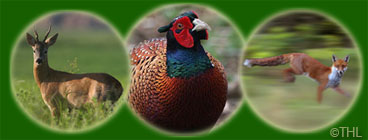A Question Of History
Over the years I have been fascinated with terriers and have picked up anything to do with them every time I had the opportunity. Books, prints, posters and videos have all been sought out and purchased, often when it would have been far more sensible to actually put the money to other, more pressing matters. But you know how it is…..
Books have been my main vice and I started like a true novice, reading dog encyclopaedias in book shops, standing mesmerised whilst trying to imagine the glossy image of the dog pictured, doing the job described. The more I read, the more I got sucked into the world of terriers, the old days in particular. There was nothing I wouldn’t read, as long as it contained a snippet of information about the dogs, I would devour it! Whether it was Hobson’s Working Terrier book (the only book I could find that remotely dealt with practicalities at that time) or a paragraph on the origin of the Cesky, I would read it.
As my tastes developed, I began to favour the books dealing with the creations of the various working breeds – what went into them, what they hoped to achieve, what quarry they were bred to face, good points and bad. Please bear in mind that I had yet to hear the word “Plummer” and all of the information I had to hand was from the older authors.
As a native of the North East, I grew up seeing Bedlingtons and to a certain extent, Sealyhams about the place on a regular basis. Through my readings, I had learned that the Bedlington was a fairly “native” dog to me and that spurred me on to find out more information. What I found out from the old books amazed me as this was not the breed that I knew. They were considered at one point to be the gamest dog alive, a match for any quarry. Robert Leighton in 1922 described them as
“This most belligerent of all the terrier tribe”
“The present day Bedlington, like a good many other terriers, has become taller and heavier then the old-day specimens. This is due to breeding for show points. He is a lathy dog, inclined to be flat sided, somewhat light in bone for his size, very lively in character and with plenty of courage. If anything, indeed, his pluck is too insistent and his gameness is apt to become aggressive: not with people so much as with other dogs. The bull terrier is a gentle, law-abiding citizen compared with the Bedlington, and when the two of the breed come to grips they are difficult to separate.”
“As a sporting terrier the Bedlington holds a position in the first rank. He is very fast and enduring, and exceedingly pertinacious, and is equally at home on land and in the water. He will work an otter, draw a badger, or bolt a fox, and he has no superior at killing rats and all kinds of vermin.”
Sounds perfect doesn’t it? But hands on heart, how many are like this these days?
Dog fighting was alluded to, always without any definite description or mention of any particular dog involved. I am aware that many types of dog have been fought over the years. You only have to look in Fitzbarnard’s book “Fighting Sports” to find mention of a Golden Retriever used in the pits and even in Lucas’ Hunt and Working Terriers there is mention of Thunder, a great fighting Airedale. For an even closer analogy, look to the Glen of Imaal terriers. Sometime fighting dog but on the whole used as a vermin dog.
Tommy Dobson famously used his chocolate Bedlington as an outcross for his terriers in order to instil a good dose of fire. Now as I read these lines, it was apparent that I wasn’t dealing with one man’s opinion, it was a widely held view that the Bedlington added guts, fire, heart – call it what you will. Nowadays people add Bedlington blood to the whippet to add coat and nose amongst other things. If people added Bedlington blood back in the day, I think they would have been adding fire too, much like a bull cross these days.
What I would like to know is when did it all go wrong for the breed? When did this canine warrior change into what we have today? Obviously there have been cosmetic changes along the way but what of the very essence of the dog? The heart. I am not trying to knock the breed as I am genuinely very fond of it. I am really trying to find out the turning pointing in its history. You hear stories of poodle being added which in turn gave rise to the Rillington strain as Mr. Newcombe became disillusioned with this practice and wanted to keep the breed pure and a worker. As far as I am aware, this addition of poodle was fairly recently? By that I mean 1960/70’s??
Can the decline of the breed as it was once known be so close in the recent past? Or was the breed changed before then? I have nothing but admiration for people who are trying to recreate the Bedlington of old and I wish them every success. I know through speaking to various people that there are still some good ones out there, and I have even seen a couple myself.
I think the Kennel Club has a lot to answer for in the ruination of many breeds. Let’s look at the Lakeland as an example. What was once, on the whole, a purely functional dog was turned into something which now is, on the whole, a purely cosmetic dog. Sure there are working strains, but these bear little resemblance to the bench variety. A similar thing happened with the Staffordshire. Upon KC recognition, they became a popular show dog. Now they are one of the most popular dogs in Great Britain. Having said that, there have always been strains of Staffords that have been kept as a working dog, either as vermin control animals or in the now illegal sport of fighting. Even dogs from lines that haven’t had workers in many generations often exhibit certain characteristics reminiscent of the original dogs. Did the same thing happen with the Bedlington? Are there working strains out there somewhere, free from the pollution of show blood? I sincerely hope so but somehow doubt it. Where are the throw backs which show themselves, like the occasional Stafford, to be cut from the old cloth? Even the Sealyham, now generally considered a non-working breed, has its working devotees, mainly in the North East - men who kept alive this once popular worker and saw to it that the breed has continued as it was meant to be.
To risk stretching a point too far, I could ask many of these questions of the Sealyham? The pre-war dog was widely considered the best badger dog around. There were quite a few arguments in “The Field” as to the finer points of the Sealyham vs the fox terrier in terms of digging to Billy, with the former usually being considered the better dog. What happened to this once glorious breed? Did KC recognition ruin this dog and the Bedlington? The Sealyham was recognised in 1911 and its glory days were yet to come. The Bedlington was recognised in 1898 and some would argue its best days were behind it. I can see no benefit in the Kennel Club recognition of a breed, to a working man. It is concerned with image and appearance rather than substance and reality. Look at any dog book and have a look at the terrier section. At one point or other, nearly all of these breeds were functional, working dogs. Now look again and ask yourself how many could do the job they were originally bred for. We have lost far too many breeds to the fancy and whim of these show people; let us not lose any more. We have precious few breeds which are true workers and too few amongst those breeds who are true specimens. Let’s consolidate what we have and look to a somewhat uncertain future with hope and pride. The future of these breeds is in our hands.
It strikes me as a great shame that we have effectively lost these breeds (as they used to be known) to the bench and all of its exaggerations and fancies. I hope the readers will forgive my dwelling on ancient history here, but by they do say that by studying history, we can avoid the same mistakes in the future and I would hate to see our workers go the same way.
I find it very amusing that the various Plummer terrier clubs are at each others throats in regards to the very thing I have written about above. One club wants KC status for “their” dog, whilst the opposing camp decries these as impostors! Why would a supposedly “working” terrier breed want KC recognition in this day and age? Surely it adds nothing to the working ability inherent in a breed? The only thing I can come up with is status, money, prestige, one-upmanship. One club wants to get their grubby hands on the pot of gold before the others do. I say good luck to them. As a wise man once said “You can’t polish a turd” but you know they are going to try!
I would like to finish by saying that I wish the very best of luck to anyone out there with the time, patience and dedication to try and breathe some life into what were once proud, hard working dogs. I take my hat off to you all.

